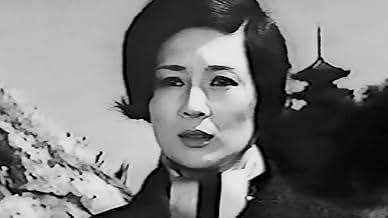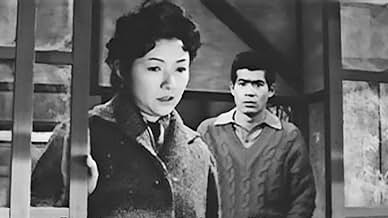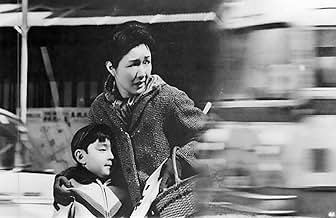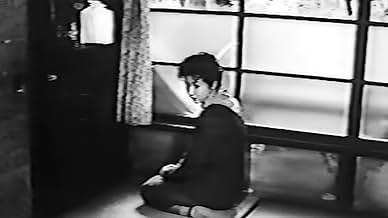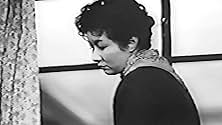A child is killed in a hit and run. The mother plots her revenge by posing as a maid in the house of the murderer.A child is killed in a hit and run. The mother plots her revenge by posing as a maid in the house of the murderer.A child is killed in a hit and run. The mother plots her revenge by posing as a maid in the house of the murderer.
- Awards
- 1 win & 1 nomination total
- Director
- Writer
- All cast & crew
- Production, box office & more at IMDbPro
Featured reviews
Naruse's third-to-last film "Onna no naka ni iru tanin" (The Stranger Within a Woman, 1966) was a change of pace from his usual home dramas: a bleak crime narrative adapted from a French novel. Perhaps the experience was pleasant for him, since he decided to venture forward on this path. "Hikinige", his second-to-last film, is the least Naruse-like film, that I have seen from the director. And I have seen 41 films from him to date.
Unlike the previous work, this one doesn't have a source novel. It is visible as narrative freedom. This film feels a little more determined about what it is going for. There are less uneven influences from foreign films too. The screenplay was written by Matsuyama Zenzo, who had frequently worked with Naruse, but also penned films for Kobayashi. This is an angry film, that is way closer to the latter, so another explanation would be that Matsuyama just sent the finished screenplay to the wrong guy. You never know.
Takamine Hideko plays a restaurant owner, whose life comes crashing down, when her young son is killed by a hit and run driver. The driver, played by Tsukasa Yoko, is the wife of a rich company president. The family pays one of their workers so that he takes the blame, but Takamine hears the truth, and decides to infiltrate the family's house, going undercover as their new maid. Her real plan, is eye for an eye.
The plot is really good, and it's a shame this didn't get made by a director more experienced in the right genre. Naruse stumbles. Many of the devices that are used to carry the psychological narrative seem cheesy. Also the film's way of showing the actions that the characters are considering in their minds really did not contribute to the whole, and made the film feel less like a thriller. As a result, this film lacks the proper intensity. The societal criticism of the film against the cold mentality of the rich was evident enough. In this theme, it clearly brings to mind Kurosawa's "Tengoku to jigoku" (High and Low, 1963). Fascinatingly, Naruse's film seems to be just as much a warning about cars and traffic. The message is that we need to be more careful.
The acting in the film is good, especially Takamine's performance. The ending was memorable, but the screenplay would have benefited from some re-working. From his two "crime" films, we can gather, that Naruse's problem with the genre is, that his usual ambiguity does not fit well here. Both of these films would work better, if they were more straight-forward, kept a pace, and ditched the elements that aren't fully developed. Still, it's brave, that a director in his old age tried something this different.
Unlike the previous work, this one doesn't have a source novel. It is visible as narrative freedom. This film feels a little more determined about what it is going for. There are less uneven influences from foreign films too. The screenplay was written by Matsuyama Zenzo, who had frequently worked with Naruse, but also penned films for Kobayashi. This is an angry film, that is way closer to the latter, so another explanation would be that Matsuyama just sent the finished screenplay to the wrong guy. You never know.
Takamine Hideko plays a restaurant owner, whose life comes crashing down, when her young son is killed by a hit and run driver. The driver, played by Tsukasa Yoko, is the wife of a rich company president. The family pays one of their workers so that he takes the blame, but Takamine hears the truth, and decides to infiltrate the family's house, going undercover as their new maid. Her real plan, is eye for an eye.
The plot is really good, and it's a shame this didn't get made by a director more experienced in the right genre. Naruse stumbles. Many of the devices that are used to carry the psychological narrative seem cheesy. Also the film's way of showing the actions that the characters are considering in their minds really did not contribute to the whole, and made the film feel less like a thriller. As a result, this film lacks the proper intensity. The societal criticism of the film against the cold mentality of the rich was evident enough. In this theme, it clearly brings to mind Kurosawa's "Tengoku to jigoku" (High and Low, 1963). Fascinatingly, Naruse's film seems to be just as much a warning about cars and traffic. The message is that we need to be more careful.
The acting in the film is good, especially Takamine's performance. The ending was memorable, but the screenplay would have benefited from some re-working. From his two "crime" films, we can gather, that Naruse's problem with the genre is, that his usual ambiguity does not fit well here. Both of these films would work better, if they were more straight-forward, kept a pace, and ditched the elements that aren't fully developed. Still, it's brave, that a director in his old age tried something this different.
Hit And Run (a direct translation from the film's Japanese title Hikinige) aka Moment Of Terror, has never been released via official means in any country (home media, streaming etc), yet I was able to get hold of an unofficial physical DVD copy which was in shockingly good quality (and in English subtitles) for such an obscure film, and what a film it is! Ah the joy (and in some parts frustration) of discovering a motion picture which knocks your socks off, yet you are the only person who knows about it.
Hit And Run is Mikio Naruse's foray into a Hitchcockian-style thriller and a film which shares a number of similarities with Akira Kurosawa's High And Low (1963), albeit a bit more schlocky (in line with the type of films Bette Davis or Joan Crawford spent the 1960's appearing in). After the unfaithful wife (Yoko Tsukasa) of a business mogul named Kakinuma (Etaro Ozawa) accidentally kills the child of single mother Kuniko (Hideko Takamine) in a hit-and-run accident, they conspire in order to save the bottom line of the company (as well as the wife covering her own back) by having their lowly chauffeur (Yutaka Sada) be the fall guy. However once Kuniko hears word of this conspiracy, she plots her revenge by posing as a maid in the house of the killer. Hit And Run is the final of the 14 film collaboration from Naruse and Hideko Takamine, as the vigilante mother whose love is taken too far. Takamine delivers one intense, angry and histrionic performance of maternal anguish, completely losing her mind come the film's conclusion in which she becomes a nervous scenery-chewing wreck. However, the film's more subtle moments do showcase Takamine's impeccable ability to convey so much without the aid of dialogue.
Comparisons to Kurosawa's High And Low quickly become evident in Hit And Run, as the business mogul of Yamano Motors Kakinuma attempts to justify his reasoning to cover up the incident in order to save the company's bottom line as well as their new product (which is ironically a high-speed motorcycle), and the calm manner in which he does so is fascinating in how it portrays the banality of evil. This is reminiscent of how Toshiro Mifune's character in High And Low attempts to do the same by justifying not paying a ransom in order to save the life of someone else's child in order to save his company. Likewise, both films showcase the stark differences between the upper and the lower classes, with both films featuring families living in a property up in the hills overlooking the plebs. Additionally, the chauffeur who takes the fall is indeed played by the same actor who portrayed the unfortunate chauffeur in High And Low, Yutaka Sada. There are no moral actors present in the Hit And Run. Kuniko's revenge goes beyond "an eye for an eye" for "a child for a child" as she attempts to murder the wife's son but at least struggles to fully go through with her intentions. The unnamed wife however (whom has a child of her own at the same age of the one she killed) is a highly reprehensible character. I never derive any sympathy for her, even when she continues to be plagued by bad dreams of the incident. Although it is never stated, it wouldn't be unlikely that the husband and wife are in an arranged marriage due to their age difference and lack of commitment.
One scene from Hit And Run involves a flashback to how Kuniko meet her late husband, a Japanese soldier who is pushed into a ditch by prostitutes as they mock him for losing the war, to which he is retrieved by Kuniko as a more sympathetic prostitute followed by a subsequent fast forward to the birth of their son. This flashback however appears to be from another movie starring Hideko Takamine as evidenced by the fact that she appears significantly younger alongside the drastic change in film grain and tone. The inclusion of this flashback is the one criticism I would have with the Hit And Run as its inclusion feels very out of place as this other film is more saccharine in tone nor does it add anything to the larger narrative. Likewise, it also throws into disarray as to when the film is actually set as the flashback is clearly set in the immediate aftermath of the war yet the film's setting is clearly contemporary for the mid-1960s. That said, would any cinema sleuths be able to identify this film within the film?
Regardless, any other criticism aimed at the very tightly plotted and brisk Hit and Run is largely inconsequential as it doesn't negatively affect the film based on the strength of its material. Some suspension of disbelief is required that the family at no point would have seen an image of Kuniko (even with her brother doing all the negotiating on her behalf, she is still seen in court). Likewise, what happened to the original maid from whom Kuniko stole the identity from? There is also a piece of set-up in which the housekeeper tells Kunkio "the boiler is dangerous, let me handle that", however, this never leads to any payoff. Throughout the film, there is also the recurring use of heightened lighting when portraying Kuniko's murder fantasies. These are cheesy and cliché but do add to the film's enjoyable schlock value, while the use of a rollercoaster to create a sense of unease is something that would be repeated time and again for years to come (Fatal Attraction, False Face, the aptly titled Rollercoaster).
At its core Hit And Run is about the dangers of automobiles and those who drive them (not exactly news to me having lived in Northern Ireland my whole life with our incredibly graphic road safety adverts). There is however a historical context for this as Takashi Oguchi of The University of Tokyo states:
"Japan has experienced an enormous increase of traffic accidents as a result of the country's rapid economic growth from the late 1950s to the year 1970. Observers in the early 1960s called the proliferation of traffic accidents the "Traffic War" as the annual traffic-accident fatalities exceeded the average annual fatalities during the First Sino-Japanese war..."
There are several moments in Hit And Run featuring some very impressive two-dimensional shots of automobiles driving by so fast in the street as the drivers give no heed to any children attempting to cross (even as a child stands alone in the middle of the road) while the film concludes on a shot featuring a scoreboard detailing the injuries and deaths from road accidents in a local area to hammer the point home. Then there is the additional metaphorical irony that the company featured in the film itself is an automobile manufacturer that is currently testing high-speed motorcycles while using the intentionally provocative slogan "gamble your life on the moment" (and even laughing that the police object to it). The film ultimately goes as far as it can with this theme without crossing the line into being preachy or overbearing. There is something all the more unsettling at the sight of a body outline when it's that of a child. Women drivers, amirite?
Hit And Run is Mikio Naruse's foray into a Hitchcockian-style thriller and a film which shares a number of similarities with Akira Kurosawa's High And Low (1963), albeit a bit more schlocky (in line with the type of films Bette Davis or Joan Crawford spent the 1960's appearing in). After the unfaithful wife (Yoko Tsukasa) of a business mogul named Kakinuma (Etaro Ozawa) accidentally kills the child of single mother Kuniko (Hideko Takamine) in a hit-and-run accident, they conspire in order to save the bottom line of the company (as well as the wife covering her own back) by having their lowly chauffeur (Yutaka Sada) be the fall guy. However once Kuniko hears word of this conspiracy, she plots her revenge by posing as a maid in the house of the killer. Hit And Run is the final of the 14 film collaboration from Naruse and Hideko Takamine, as the vigilante mother whose love is taken too far. Takamine delivers one intense, angry and histrionic performance of maternal anguish, completely losing her mind come the film's conclusion in which she becomes a nervous scenery-chewing wreck. However, the film's more subtle moments do showcase Takamine's impeccable ability to convey so much without the aid of dialogue.
Comparisons to Kurosawa's High And Low quickly become evident in Hit And Run, as the business mogul of Yamano Motors Kakinuma attempts to justify his reasoning to cover up the incident in order to save the company's bottom line as well as their new product (which is ironically a high-speed motorcycle), and the calm manner in which he does so is fascinating in how it portrays the banality of evil. This is reminiscent of how Toshiro Mifune's character in High And Low attempts to do the same by justifying not paying a ransom in order to save the life of someone else's child in order to save his company. Likewise, both films showcase the stark differences between the upper and the lower classes, with both films featuring families living in a property up in the hills overlooking the plebs. Additionally, the chauffeur who takes the fall is indeed played by the same actor who portrayed the unfortunate chauffeur in High And Low, Yutaka Sada. There are no moral actors present in the Hit And Run. Kuniko's revenge goes beyond "an eye for an eye" for "a child for a child" as she attempts to murder the wife's son but at least struggles to fully go through with her intentions. The unnamed wife however (whom has a child of her own at the same age of the one she killed) is a highly reprehensible character. I never derive any sympathy for her, even when she continues to be plagued by bad dreams of the incident. Although it is never stated, it wouldn't be unlikely that the husband and wife are in an arranged marriage due to their age difference and lack of commitment.
One scene from Hit And Run involves a flashback to how Kuniko meet her late husband, a Japanese soldier who is pushed into a ditch by prostitutes as they mock him for losing the war, to which he is retrieved by Kuniko as a more sympathetic prostitute followed by a subsequent fast forward to the birth of their son. This flashback however appears to be from another movie starring Hideko Takamine as evidenced by the fact that she appears significantly younger alongside the drastic change in film grain and tone. The inclusion of this flashback is the one criticism I would have with the Hit And Run as its inclusion feels very out of place as this other film is more saccharine in tone nor does it add anything to the larger narrative. Likewise, it also throws into disarray as to when the film is actually set as the flashback is clearly set in the immediate aftermath of the war yet the film's setting is clearly contemporary for the mid-1960s. That said, would any cinema sleuths be able to identify this film within the film?
Regardless, any other criticism aimed at the very tightly plotted and brisk Hit and Run is largely inconsequential as it doesn't negatively affect the film based on the strength of its material. Some suspension of disbelief is required that the family at no point would have seen an image of Kuniko (even with her brother doing all the negotiating on her behalf, she is still seen in court). Likewise, what happened to the original maid from whom Kuniko stole the identity from? There is also a piece of set-up in which the housekeeper tells Kunkio "the boiler is dangerous, let me handle that", however, this never leads to any payoff. Throughout the film, there is also the recurring use of heightened lighting when portraying Kuniko's murder fantasies. These are cheesy and cliché but do add to the film's enjoyable schlock value, while the use of a rollercoaster to create a sense of unease is something that would be repeated time and again for years to come (Fatal Attraction, False Face, the aptly titled Rollercoaster).
At its core Hit And Run is about the dangers of automobiles and those who drive them (not exactly news to me having lived in Northern Ireland my whole life with our incredibly graphic road safety adverts). There is however a historical context for this as Takashi Oguchi of The University of Tokyo states:
"Japan has experienced an enormous increase of traffic accidents as a result of the country's rapid economic growth from the late 1950s to the year 1970. Observers in the early 1960s called the proliferation of traffic accidents the "Traffic War" as the annual traffic-accident fatalities exceeded the average annual fatalities during the First Sino-Japanese war..."
There are several moments in Hit And Run featuring some very impressive two-dimensional shots of automobiles driving by so fast in the street as the drivers give no heed to any children attempting to cross (even as a child stands alone in the middle of the road) while the film concludes on a shot featuring a scoreboard detailing the injuries and deaths from road accidents in a local area to hammer the point home. Then there is the additional metaphorical irony that the company featured in the film itself is an automobile manufacturer that is currently testing high-speed motorcycles while using the intentionally provocative slogan "gamble your life on the moment" (and even laughing that the police object to it). The film ultimately goes as far as it can with this theme without crossing the line into being preachy or overbearing. There is something all the more unsettling at the sight of a body outline when it's that of a child. Women drivers, amirite?
Hideko Takamine spoils her fatherless child. Even her Yakuza brother tells her that. So she is devastated when he is run over in a traffic accident. The driver was Yôko Tsukasa, but she sped on when she thought the child was all right, because she was in the car with her lover. However, when she gets home, she discovers blood on the front bumper. She wants to confess, but her husband, Eitarô Ozawa, is about to be promoted to company president. He bribes a staff driver to take the blame, arranges to pay 1.2 million yen to Miss Takamine. The driver gets a 30,000 yen fine -- about $100 in contemporary money.
Miss Takamine finds out it was a woman who was driving, realizes it was Miss Tsukasa. She changes her name, goes to working for an agency and soon is working in the lady's household. She fantasizes about killing Miss Tsukasa's boy, about killing Miss Tsukasa. Miss Tsukasa has nightmares, her boyfriend is leaving the country, and she realizes that her entire marriage is a mistake.
It's not the sort of movie one associates Miss Takamine with, nor the director, Mikio Naruse, nor the writer, Zenzô Matsuyama -- although the sharply written characters are certainly in his line. The suffering of the women is typical of Naruse, and that makes it a little more typical for the director, although the situations are offbeat for him.
It's a very good film, as you would expect with the talent, even if it is not what one would expect of any of them.
Miss Takamine finds out it was a woman who was driving, realizes it was Miss Tsukasa. She changes her name, goes to working for an agency and soon is working in the lady's household. She fantasizes about killing Miss Tsukasa's boy, about killing Miss Tsukasa. Miss Tsukasa has nightmares, her boyfriend is leaving the country, and she realizes that her entire marriage is a mistake.
It's not the sort of movie one associates Miss Takamine with, nor the director, Mikio Naruse, nor the writer, Zenzô Matsuyama -- although the sharply written characters are certainly in his line. The suffering of the women is typical of Naruse, and that makes it a little more typical for the director, although the situations are offbeat for him.
It's a very good film, as you would expect with the talent, even if it is not what one would expect of any of them.
Did you know
- ConnectionsVersion of Herupâ Haruko no sennyûki: Nani ga haha wo sôsaseta!? (2005)
Details
- Release date
- Country of origin
- Language
- Also known as
- Moment of Terror
- Production company
- See more company credits at IMDbPro
- Runtime1 hour 40 minutes
- Color
- Sound mix
- Aspect ratio
- 2.35 : 1
Contribute to this page
Suggest an edit or add missing content



